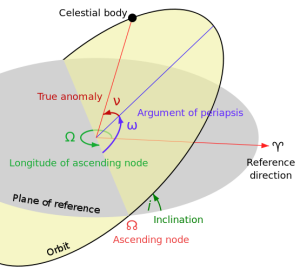The traditional orbital elements that identify a specific orbit are the six Keplerian parameters.
The main two elements that define the shape and size of the ellipse:
Eccentricity (e): shape of the ellipse, describing how much it is elongated compared to a circle (e = 0 circular orbit; e < 1 elliptical orbit; e > 1 hyperbolic trajectory; e = 1 parabolic trajectory). Galileo orbits typical range value is from 0.0001 to 0.0006, thus they are near-circular orbits.
Semimajor axis: the sum of the periapsis (point of closest approach) and apoapsis (point of farthest excursion) distances divided by two. Typical Galileo orbits semimajor axis value is around 29,500km.
Two elements define the orientation of the orbital plane in which the ellipse is embedded:
Inclination (i): vertical tilt of the ellipse with respect to the reference plane (equatorial plane), measured at the ascending node (where the orbit passes upward through the equatorial plane). Typical Galileo orbits inclination is 55º-56º.
Longitude of the ascending node or right ascension of the ascending node (O): angle between the reference plane’s vernal point and the ascending node, measured CCW from vernal equinox.
And finally:
Argument of periapsis (ω): angle measured from the ascending node to the periapsis, defining the orientation of the ellipse in the orbital plane.
Mean anomaly: defines the position of the satellite along the ellipse at a precise epoch. It is not a geometric angle. However, it can be converted into the true anomaly (ν) which is the angle between periapsis and the position of the orbiting object (satellite).
Next these six Keplerian parameters are shown graphically:
The Galileo satellites updated Keplerian parameteres can be checked in CelesTrak website.

